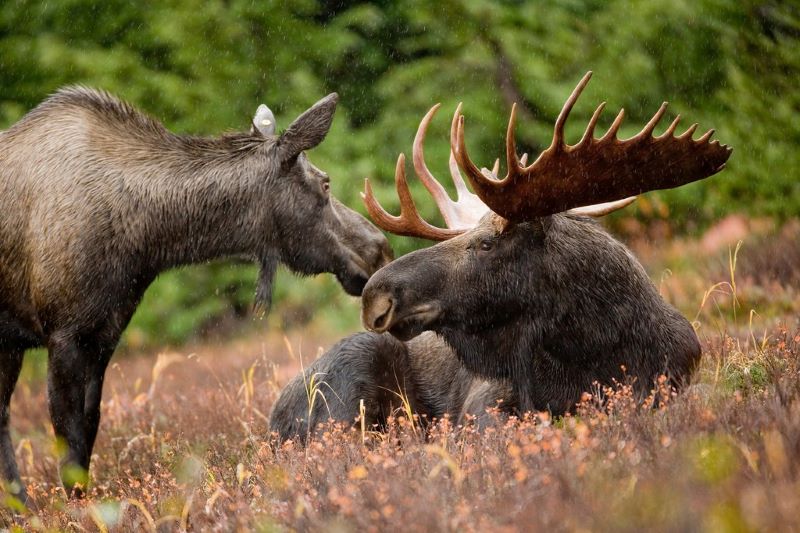LS2.A Interdependent Relationships in Ecosystems
Below are lesson resources for the Disciplinary Core Idea Interdependent Relationships in Ecosystems.
Looking at Vegetative Growth and Elevation

Image: faungg - licensed under the CC Attribution-NoDerivs 2.0 Generic license.
Grade Level: 6-8
Performance Expectation Connections:
MS-LS1-4. Use argument based on empirical evidence and scientific reasoning to support an explanation for how characteristic animal behaviors and specialized plant structures affect the probability of successful reproduction of animals and plants respectively.
MS-LS2-4. Construct an argument supported by empirical evidence that changes to physical or biological components of an ecosystem affect populations.
Science and Engineering Practices: Engaging in Argument From Evidence; Analyzing and Interpreting Data
Crosscutting Concepts: Patterns; Cause and Effect
Disciplinary Core Ideas: Adaptation; Interdependent Relationships in Ecosystems; Ecosystem Dynamics, Functioning, and Resilience; Biodiversity and Humans
Possible Guiding Questions: Why is there a treeline? How can certain areas have similar climate but very different vegetation? How have different plants adapted to different elevations? How might climate change impact vegetation patterns on mountains?
Possible Instructional Uses: You may use this phenomenon to explore the relationship between environmental conditions and elevation, life zones, adaptations to different ecosystems, and climate change’s impact on vegetation.
Contributors: Martha Inouye, Clare Gunshanen, Sienna Wessel, Matthew Bisk
Date Uploaded: 11/11/21
Vegetative Communities and Climate Change

Image: Adam Zolyak - licensed under the CC Attribution-NonCommerical-NoDerivs 2.0 Generic license
Grade Level: 9-12
Performance Expectation Connections:
HS-LS2-2. Use mathematical representations to support and revise explanations based on evidence about factors affecting biodiversity and populations in ecosystems of different scales.
HS-LS4-5. Evaluate the evidence supporting claims that changes in environmental conditions may result in: (1) increases in the number of individuals of some species, (2) the emergence of new species over time, and (3) the extinction of other species.
Science and Engineering Practices: Engaging in Argument From Evidence; Analyzing and Interpreting Data; Using Mathematics and Computational Thinking
Crosscutting Concepts: Patterns; Cause and Effect
Disciplinary Core Ideas: Adaptation; Interdependent Relationships in Ecosystems; Ecosystem Dynamics, Functioning, and Resilience; Biodiversity and Humans; Weather and Climate; Global Climate Change
Possible Guiding Questions: Why does treeeline exist on mountains? How does temperature, precipitation, and elevation affect vegetative communities? Why do certain communities of plants grow in certain locations and under certain conditions? How might climate change impact the presence of treeline on mountains? What impacts would a loss of alpine environment have on humans? How might climate change affect the plant communities that we live near?
Possible Instructional Uses: This phenomenon provides an entrance point into discussing how various environmental conditions, such as temperature and precipitation, impact the communities of plants that grow in certain areas. There is also an opportunity to explore how climate change will impact plant communities, including how threats to alpine environments would affect humans.
Contributors: Martha Inouye, Clare Gunshanen, Sienna Wessel, Matthew Bisk
Date Uploaded: 11/11/21
Ungulate Range: Vegetation, Habitat, and Climate

Image: Ryan Hagerty/USFWS - licensed under the CC Attribution 2.0 Generic license.
Grade Level: 6-8
Performance Expectation Connections:
MS-LS2-1. Analyze and interpret data to provide evidence for the effects of resource availability on organisms and populations of organisms in an ecosystem.
MS-LS1-5. Construct a scientific explanation based on evidence for how environmental and genetic factors influence the growth of organisms.
MS-LS2-2. Construct an explanation that predicts patterns of interactions among organisms across multiple ecosystems.
Science and Engineering Practices: Constructing Explanations and Designing Solutions; Analyzing and Interpreting Data
Crosscutting Concepts: Patterns; Cause and Effect
Disciplinary Core Ideas: Interdependent Relationships in Ecosystems; Growth and Development of Organisms
Possible Guiding Questions: Why do ungulates live in certain habitats? What factors influence whether an animal will live in a specific area? How might vegetation influence ungulate distribution? How might climate influence ungulate distribution? How might ungulate populations respond to differences in their environment (introduction of predator, climate change, etc.)?
Possible Instructional Uses: This lesson may be used to explore the relationship between animals and their habitats. You may choose to approach it from the perspective of vegetation, diet, or climate. This lesson can also serve as a jumping off point for a discussion on human impacts on ungulate populations and the effects of current management plans.
Contributors: Rhiannon Jakopak, Martha Inouye, Clare Gunshanen, Matthew Bisk
Date Uploaded: 2/7/22
